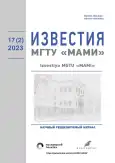Инновационные разработки по применению водорода на транспортных ДВС и в силовых установках
- Авторы: Шабанов А.В.1, Дунин А.Ю.2, Ванин В.К.1
-
Учреждения:
- Научно-исследовательский Центр по испытаниям и доводке автомототехники Научно-исследовательского автомобильного и автомоторного института (НАМИ)
- Московский автомобильно-дорожный государственный технический университет (МАДИ)
- Выпуск: Том 17, № 2 (2023)
- Страницы: 115-126
- Раздел: Тепловые двигатели
- URL: https://journals.rcsi.science/2074-0530/article/view/253968
- DOI: https://doi.org/10.17816/2074-0530-430189
- ID: 253968
Цитировать
Полный текст
Аннотация
Обоснование. В статье проанализированы инновационные технологии и конструкторские решения, направленные на применение водорода в двигателях внутреннего сгорания (ДВС) и силовых водородных установках. Показаны преимущества водородного топлива и обозначены основные проблемы, c которыми сталкиваются западные автопроизводители и которые определяют пути решения проблем на автотранспорте. В этой связи метод использования энергии водорода в ДВС и силовых водородных установках становится решающим фактором.
Цель работы ― поиск рационального и эффективного метода применения водорода на транспорте.
Материалы и методы. Рассмотрены технологии получения водорода электролизным методом и генерированием водорода на борту автомобиля из водородосодержащих компонентов. Предложено использовать аммиак в качестве реагента-носителя водорода для работы в двух топливных дизельных ДВС.
Результаты. Отмечается, что аммиак, при высоком уровне содержания водорода в молекуле, относительно безопасен, имеет низкую стоимостью и значительный объем производства. Его проще хранить и транспортировать по сравнению с водородом. Для ДВС, работающем на углеводородным топливе, использование аммиака и его производного продукта водорода привлекательно необходимостью удаления высоко токсичных оксидов азота, содержащихся в выхлопных газах дизельных ДВС.
Рассмотрена одна из основных проблем создания экологически чистого дизельного ДВС связанная со снижением NOx до экологически безопасного уровня. Положительным фактором применения аммиака является генерирование водорода в термическом реакторе на борту автомобиля, а также возможность организации эффективного процесса нейтрализации оксидов азота в дизельном ДВС.
Заключение. Применение аммиака для генерирования водорода позволяет в дизельном ДВС реализовать процесс селективного восстановления оксидов азота при впрыскивании аммиака в камеру сгорания на такте выпуска.
Данный метод позволяет существенно повысить эффективность нейтрализации NОх в дизельном ДВС, за счет возможности температурного регулирования реакции нейтрализации NОх непосредственно в цилиндре и в выпускной системе ДВС.
Полный текст
Открыть статью на сайте журналаОб авторах
Александр Викторович Шабанов
Научно-исследовательский Центр по испытаниям и доводке автомототехники Научно-исследовательского автомобильного и автомоторного института (НАМИ)
Автор, ответственный за переписку.
Email: saaha-1955@mail.ru
ORCID iD: 0000-0002-2742-5311
SPIN-код: 2711-5000
канд. техн. наук, эксперт «Экспертного отдела»
Россия, 125438, Москва, ул. Автомоторная, д. 2Андрей Юрьевич Дунин
Московский автомобильно-дорожный государственный технический университет (МАДИ)
Email: a.u.dunin@yandex.ru
ORCID iD: 0000-0003-0676-4135
SPIN-код: 3964-8620
доктор технических наук, профессор кафедры "Теплотехника и автотракторные двигатели", доцент
Россия, 125319, Москва, Ленинградский проспект, д. 64Владимир Константинович Ванин
Научно-исследовательский Центр по испытаниям и доводке автомототехники Научно-исследовательского автомобильного и автомоторного института (НАМИ)
Email: v.vanin@nami.ru
ORCID iD: 0009-0009-8370-7354
главный специалист
Россия, 125438, Москва, ул. Автомоторная, д. 2Список литературы
- Мастепанов А., Араи Х. Водородная стратегия Японии // Энергетическая политика. 2020. № 11(153). С. 62–73. doi: 10.46920/2409-5516_2020_11153_62
- Дунин А.Ю., Шабанов А.В., Нгуен Т.К., и др. Улучшение энергетических и экологических показателей дизельного ДВС путем применения водородосодержащей добавки // Известия МГТУ “МАМИ“. 2022. Т. 16, № 2. C. 125–133. doi: 10.17816/2074-0530-108908
- Столяревский А.Я. Технология производства водороднометановой смеси для автотранспорта // Наука и техника в газовой промышленности. 2008. № 3 . С. 73–80.
- Технико-экономическая оценка различных вариантов хранения водорода. https://studme.org/152663/tehnika/tehniko_ ekonomicheskaya_otsenka_razlichnyh_variantov_hraneniya_ vodoroda (дата обращения: 25.07.2023)
- Раменский A.Ю., Шелищ П.Б., Нефедкин С.И. Применение водорода в качестве моторного топлива для автомобильных двигателей внутреннего сгорания. история, настоящее и перспективы // Альтернативная энергетика и экология (ISJAEE). 2006. № 11(43). С. 63–70.
- Попель О.С., Тарасенко А.Б. Водородная энергетика – возможные пути развития в условиях России // VII всероссийская конференция с международным участием «Топливные элементы и энергоустановки на их основе» Сборник трудов. Москва: МФТИ, 2020. С. 42–46.
- Пономарев-Степной Н.Н., Столяревский А.Я. Атомно-водородная энергетика – пути развития // Энергия. 2004. № 1. С. 3–9. Масленников Д.С. Особенности применение водорода для повышения эффективности процесса сгорания бензинового ДВС на режиме холостого хода. Магистерская диссертация Тольятти, 2019.
- Andrea T.D., Henshaw P.F., Ting D.S.K. Formation and restraint of toxic emissions in hydrogen-gasoline mixture fuelled. engine // International Journal of Hydrogen Energy. 1998. Vol. 23. P. 971–5.
- Кавтарадзе Р.З., Сун Б., Голосов А.С., и др. Эффективные показатели водородного двигателя с модифицированной системой топливоподачи при работе на обеднённой смеси // Труды НАМИ. 2021. № 3(286). C. 58–64.
- Пономарев-Степной Н.Н., Столяревский А.Я. Международный проект создания паровой конверсии метана с выделением водорода. Атомно-водородная энергетика пути развития // Энергия. 2004. № 1. С. 3–9.
- Фомин В.М., Каменев В.Ф., Хергеледжи М.В. Бортовое генерирование водородосодержащего газа для транспортных двигателей // Транспорт на альтернативном топливе. 2013. № 2(32).
- С. 41–47.
- Каким должно быть топливо будущего. Все, что нужно знать о водородном топливе будущего. Методы получения H2. https://www.avtoprin.ru/deprivation/kakim-dolzhno-byt-toplivobudushchego-vse-chto-nuzhno-znat-o-vodorodnom/ (дата обращения 25.07.2023)
- Савостьянов А.П., Кравченко О.А. Водородная энергетика и технологии. Новочеркасск: Южно-Российский государственный политехнический университет (НПИ) имени М.И. Платова, 2021.
- Фомин В.М. Повышение эффективности использования альтернативного топлива на транспорте // Известия МГТУ “МАМИ“. 2016. Т. 10, № 2. C. 84–92. doi: 10.17816/2074-0530-66945
- Каменев В.Ф., Фомин В.М., Апелинский Д.В., и др. Генерирование водородосодержащего газа на борту транспортного средства // Известия МГТУ “МАМИ“. 2013. Т. 7, № 1–1. C. 204–212. doi: 10.17816/2074-0530-68332
- Фомин В.М., Каменев В.Ф. Предварительное термохимичекое преобразование топлива в системах питания двигателей внутреннего сгорания // Вестник РУДИ. Серия. Инженерные исследования. 2003. № 1. С. 59–65.
- Фомин В.М. Эффективное применение водородных энергоресурсов в структуре энергообеспечения АПК // Тракторы и сельхозмашины. 2014. Т. 81, № 6. C. 3–7. doi: 10.17816/0321-4443-65540
- Использование аммиака для хранения и транспортировки возобновляемой энергии. https://h2.d3.ru/ispolzovanie-ammiakadlia-khraneniia-i-transportirovki-vozobnovliaemoi-energii2140871/?sorting=rating (дата обращения: 25.07.2023)
- MAN возглавляет новый проект на четырехтактном ДВС, работающем на аммиаке. https://www.marinelog.com/technology/ project-on-ammonia-fueled-four-strokes-kicks-off/ (дата обращения: 25.07.2023)
- Шабанов А.В., Кондратьев Д.В., Ванин В.К., и др. К вопросу повышения эффективности систем нейтрализации оксидов азота в дизельных ДВС // Известия МГТУ “МАМИ“. 2021. Т. 15, № 2. C. 101–112. doi: 10.31992/2074-0530-2021-48-2-101-112 22.
- Кутенев В.Ф., Кисуленко Б.В., Шюте Ю.В. Экологическая безопасность автомобилей с двигателями внутреннего сгорания. М.: Экология. Машиностроение, 2009.
Дополнительные файлы











